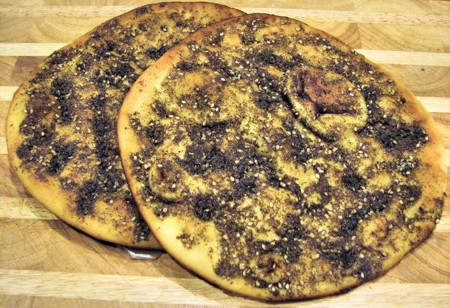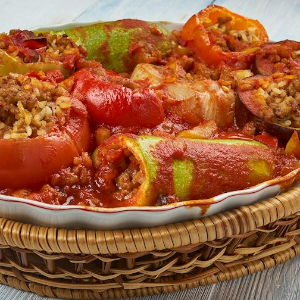If you look at a traditional map of North Africa, Libya looks pretty desolate: Not many main roads showing and not many major cities. “Well,” you reason. “It is in the middle the Sahara Desert…” And you may not bother to look closer. But it’s an ancient and mysterious land that deserves our attention…
 Za’atar: Also referred to elsewhere on this blog as North Africa’s and
Za’atar: Also referred to elsewhere on this blog as North Africa’s and
the Middle East’s contribution to the global Pizza legacy.
It’s a classic mistake that so many Victorian era Europeans made about Egypt: they assumed it was just barren desert whose lone and level sands stretched far away on every side – punctuated by shockingly lush oases and the occasional pyramid. But, just as we looked only at the map, they looked only at black and white line drawings and (later) early photographs published in the rotogravures.
And, in doing so, they never realized that Egypt was actually teeming with contemporary life along its Mediterranean coastline and the Nile Valley. Similarly, Libya is an exotic land of plenty along the Med, and over the millennia has developed a rich and varied cuisine all its own.
This morning, we present a few choice Libyan dishes that demonstrate the variety, colour and originality of the country’s ancient cuisine.
(Many thanks to tasteatlas.com for it’s suggestions and clear, concise descriptions of these eye-opening delectables…z0
Our menu for today…
Bazin: Virtually everyone in Libya eats Bazin, the region’s unleavened bread (also considered a dough-based dish) made by boiling barley flour and salt in water and beating it with a stick called magraf until it develops into a dough which is then baked or steamed. The bread is characterized by its hard texture, achieved by the usage of large amounts of salt. It is traditionally shared and consumed using the right hand. Bazin is often served with a tomato-based stew, potatoes, hard-boiled eggs, and mutton.
Za’atar (photo above) is a traditional spice blend with Middle Eastern and Levantine origins. The ingredients used in za’atar vary from region to region, and the list often includes the wild za’atar herb (hyssop, growing throughout the Levant), marjoram, thyme, oregano, coriander, cumin, toasted sesame seeds, sumac, and salt. The sumac imparts a lemony, citrusy flavor; oregano gives a slight bitterness; marjoram gives notes of sweetness. The spice blend is commonly sprinkled over soups, dips, bread, meat, rice, pasta, vegetables, or rice dishes. One of the most popular and common street foods in the region is za’atar bread – consisting simply of the herb blend generously sprinkled over local flatbread and baked on.
Kufta bil batinjal is a flavorful Libyan dish made by wrapping traditional Arabian kuftas in aubergine slices. The kufta mixture consists of ground meat, onions, breadcrumbs, eggs, and flavorings such as parsley, black pepper, cinnamon, nutmeg, and chile powder. Cooked kuftas are then wrapped in aubergine slices which were previously grilled or fried. The dish is served in a spicy tomato sauce made with tomatoes, garlic, chile peppers, and olive oil. It is recommended to pair kufta bil batinjal with a heap of rice on the side.
Hasa adas is a healthy Lybian soup that is also suitable for vegetarians. It has a thick consistency and is typically made with lentils, carrots, onions, and tomatoes. The soup is traditionally flavored with garlic and cumin. Once prepared, hasa adas is garnished with crispy and sweet caramelized onions or toasted pieces of bread. When made with dried meat, the soup is often poured over toasted Arabic bread, and the creation is then called fattat adas, usually consumed as a warming winter dish. Hearty, flavourful and requiring only a few ingredients, Hasa adas relatively quick and east to throw together.
Couscous bil-bosla is a traditional Libyan dish made with a combination of couscous, chickpeas, potatoes, tomatoes, and lamb. Other ingredients used in the dish include onions, butter, chili peppers, and various spices. When served, couscous is arranged on a platter and topped with the lamb chops, and the whole dish is then covered with the chickpea sauce. The dish is traditionally served, as is the ubiquitous Rice, on a large sharing platter. As it is elsewhere in Africa, couscous is often used interchangeably with Rice.
Tajin mahshi (photo, top of page) is a flavorful Lybian dish that is typically served as a main meal or a side dish. It consists of a variety of stuffed vegetables such as bell peppers, tomatoes, aubergines, and courgettes. The filling is usually prepared with a combination of ground meat, onions, rice, and spices such as chiles, salt, pepper, turmeric, ginger, and cinnamon. It is said that tajin mahshi tastes even better when reheated the next day. Mahishi is just one of Libya’s contributions to the universal Med cookbook of Tajine-prepared dishes.
Salata mashwiya is a spicy Libyan dish that can be served either as a salad or a hot sauce accompanying barbecued meat and freshly baked bread (like Salsa Cruda in Tex-Mex cuisine). It consists of tomatoes, bell peppers, onions, eggplants, hot chiles, and garlic. The salad is typically flavored with ground caraway seeds and garnished with olives and hard-boiled eggs. The name of the dish means roasted salad, and it is known by that name in both Libya and Tunisia, where salata mashwiya is also quite popular.
Notes on Libyan culture and influence…
- There’s a lot of mutton in Libya, as in coastal Egypt and throughout the middle east.
- Many Libyan cuisine features are also popular in neighbouring states such as Tunisia, and Liberia.
- Eating with the hands is common in N. African, Middle east and Mediterranean countries, in general; using flatbreads as scoops, etc.
- Throughout the third world, there is only one thing that’s done with the left hand – to be delicate about it – and that involves privacy, squatting, and a bowl of warm water. So it is, and has been since time immemorial.
My take
I’m guessing that occasional meetings between the people of all the various North African countries contributed a lot to the sharing of recipies, ingredient ideas and such like. Other speculate that the Southern Coast of the Med Sea was populated by migration of a seed population which came out of what is now Egypt. The overall result has been very much the same wherever you go.
Although portions of most, if not all, of the North African nations rely on fishing and seafood gathering for their livelihoods, and use a lot of recipes featuring such ingredients, there is not a great deal of difference in their preferences and preparations: Sardines, Shellfish, etc. can be found everywhere along the shore. Stewing, frying and skewering are common styles of cooking them.
~ Maggie J.

